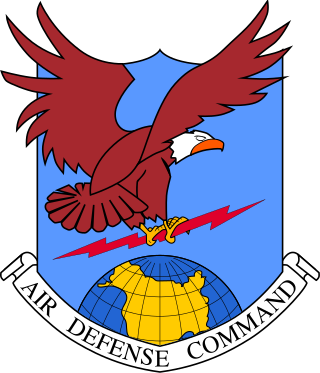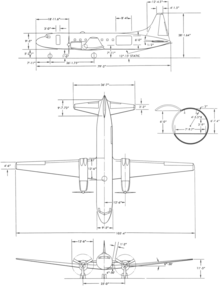
The Boeing T-43 is a retired modified Boeing 737-200 that was used by the United States Air Force for training navigators, now known as USAF combat systems officers, from 1973 to 2010. Informally referred to as the Gator and "Flying Classroom", nineteen of these aircraft were delivered to the Air Training Command (ATC) at Mather Air Force Base, California during 1973 and 1974. Two additional aircraft were delivered to the Colorado Air National Guard at Buckley Air National Guard Base and Peterson Air Force Base, Colorado, in direct support of cadet air navigation training at the nearby U.S. Air Force Academy. Two T-43s were later converted to CT-43As in the early 1990s and transferred to Air Mobility Command (AMC) and United States Air Forces in Europe (USAFE), respectively, as executive transports. A third aircraft was also transferred to Air Force Materiel Command (AFMC) for use as the "Rat 55" radar test bed aircraft and was redesignated as an NT-43A. The T-43A was retired by the Air Education and Training Command (AETC) in 2010 after 37 years of service.

The Convair XC-99, AF Ser. No. 43-52436, is a prototype heavy cargo aircraft built by Convair for the United States Air Force. It was the largest piston-engined land-based transport aircraft ever built, and was developed from the Convair B-36 Peacemaker bomber, sharing the wings and some other structures with it. The first flight was on 24 November 1947 in San Diego, California, and after testing it was delivered to the Air Force on 26 May 1949. The Convair Model 37 was a planned civil passenger variant based on the XC-99 but was not built.

The Fairchild C-123 Provider is an American military transport aircraft designed by Chase Aircraft and built by Fairchild Aircraft for the U.S. Air Force. In addition to its USAF service, which included later service with the Air Force Reserve and the Air National Guard, it went on to serve the U.S. Coast Guard and various air forces in Southeast Asia. During the War in Vietnam, the C-123 was used to deliver supplies, to evacuate the wounded, for agent insertions behind enemy lines, and was also used to spray Agent Orange.

The Douglas DC-6 is a piston-powered airliner and cargo aircraft built by the Douglas Aircraft Company from 1946 to 1958. Originally intended as a military transport near the end of World War II, Douglas reworked it after the war to compete with the Lockheed Constellation in the long-range commercial transport market. Douglas built over 700, and many still fly in cargo, military, and wildfire control roles.

The Lockheed EC-121 Warning Star is an American airborne early warning and control radar surveillance aircraft operational in the 1950s in both the United States Navy (USN) and United States Air Force (USAF).

The Lockheed JetStar is a business jet produced from the early 1960s to the 1970s. The JetStar was the first dedicated business jet to enter service, as well as the only such airplane built by Lockheed. It was also one of the largest aircraft in the class for many years, seating ten plus two crew. It is distinguishable from other small jets by its four engines, mounted on the rear of the fuselage, and the "slipper"-style fuel tanks fixed to the wings.

The Air Education and Training Command (AETC) is one of the nine Major Commands (MAJCOM) of the United States Air Force (USAF), reporting to Headquarters, United States Air Force. It was established 1 July 1993, with the realignment of Air Training Command and Air University.

The Convair CV-240 is an American airliner that Convair manufactured from 1947 to 1954, initially as a possible replacement for the ubiquitous Douglas DC-3. Featuring a more modern design with cabin pressurization, the 240 series made some inroads as a commercial airliner, and had a long development cycle that produced various civil and military variants. Though reduced in numbers by attrition, various forms of the "Convairliners" continue to fly in the 21st century.

On 17 December 1960, a Convair C-131D Samaritan operated by the United States Air Force on a flight from Munich to RAF Northolt crashed shortly after take-off from Munich-Riem Airport, due to fuel contamination. All 20 passengers and crew on board as well as 32 people on the ground were killed.

Hill Aerospace Museum is a military aviation museum located at Hill Air Force Base in Roy, Utah. It is dedicated to the history of the base and aviation in Utah.

The 1254th Air Transport Wing was a United States Air Force unit, existing between 1948 and 1966. It was last stationed at Andrews AFB, Maryland.

Finley Air Force Station is a closed United States Air Force General Surveillance Radar station. It is located 1.5 miles (2.4 km) west-northwest of Finley, North Dakota. It was closed in 1979 by the Air Force, and turned over to the Federal Aviation Administration (FAA).

The Pueblo Weisbrod Aircraft Museum is a non-profit aviation museum located in Southern Colorado. It was founded in the mid-1970s by former Pueblo City Manager Fred Weisbrod. The museum is made up of two hangars that were built in 2005 and 2011. The hangars house several of the museum's aircraft along with thousands of artifacts dating from World War I to modern day. PWAM is home to the International B-24 Memorial Museum and the Southern Colorado Space Museum and Learning Center. There are several historic military vehicles in the museum's collection, many of which are still in operational condition. The museum is located six miles east of Pueblo, Colorado on US Highway 50 at the Pueblo Memorial Airport, occupying space on what was the Pueblo Army Air Base during World War II. It is managed and maintained by the Pueblo Historical Aircraft Society.

The 99th Airlift Squadron is part of the 89th Airlift Wing at Andrews Air Force Base, Maryland. The 99th AS directly supports the Vice President, members of the Cabinet, Congress, and other U.S. and foreign dignitaries. The squadron flies specially configured C-37 Gulfstream V aircraft on Special Air Missions directed by Headquarters United States Air Force.

The Lockheed C-121 Constellation is a military transport version of the Lockheed Constellation. A total of 332 aircraft were constructed for both the United States Air Force and United States Navy for various purposes. Numerous airborne early warning versions were also constructed. The C-121 later saw service with smaller civilian operators until 1993.

The Boeing C-137 Stratoliner is a retired VIP transport aircraft derived from the Boeing 707 jet airliner used by the United States Air Force. Other nations also bought both new and used 707s for military service, primarily as VIP or tanker transports. In addition, the 707 served as the basis for several specialized versions, such as the E-3 Sentry AWACS aircraft. The designation C-18 covers several later variants based on the 707-320B/C series. The C-137 should not be confused with the similar Boeing C-135 Stratolifter; although they share a common ancestor the two aircraft have different fuselages, among other structural differences.

The Air Mobility Command Museum is a military aviation museum located at Dover Air Force Base in Dover, Delaware dedicated to the history of the Air Transport Command, Military Air Transport Service, Military Airlift Command and Air Mobility Command.

The Douglas R4D-8 is a military transport aircraft developed from the civilian Douglas DC-3S airliner. It was used by the United States Navy and United States Marine Corps during the Korean War and Vietnam War.

The Convair NC-131H Samaritan, also known as the Total In-Flight Simulator (TIFS), is a modified Convair C-131 Samaritan that was used to study aircraft handling characteristics. Built as a C-131B, the aircraft underwent extensive conversion and modification by the United States Air Force, NASA, Calspan and others from the late 1960s until the 2000s. TIFS' maiden flight was in 1970.


























